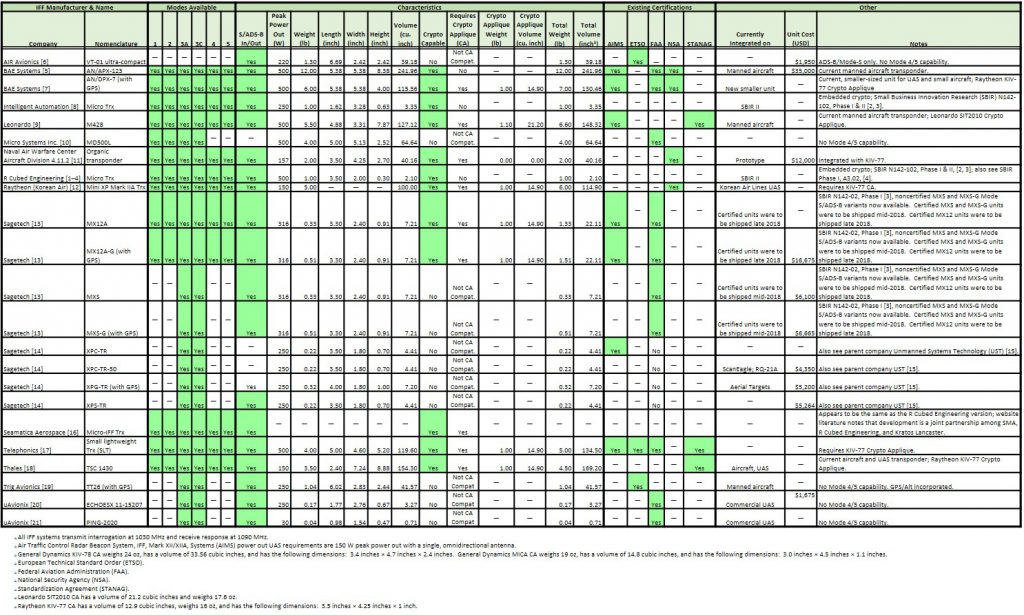an email newsletter released every month highlighting the latest articles, events, technical inquires, and voices from the community
Small/Micro Identification Friend or Foe (IFF) Transponder Survey

Posted on February 16, 2018 | Completed on February 28, 2018 | By: Scott E. Armistead
What small/micro Identification, Friend or Foe (IFF) transponders could be used in small UAVs?
The Defense Systems Information Analysis Center (DSIAC) worked with Georgia Tech Research Institute and various transponder manufacturers to survey and catalog small and micro-sized identification friend or foe (IFF) transponders that could be candidates for use in small (i.e., Group 1) unmanned aerial vehicles. The smallest of these transponders weighs only a few ounces and occupies only a few cubic inches of volume. DSIAC generated a response document that catalogs over 20 IFF transponders.
1.0 Introduction
The Defense Systems Information Analysis Center (DSIAC) staff and subject matter experts from SURVICE Engineering and Georgia Tech Research Institute (GTRI) surveyed open sources (e.g., websites, fact sheets, etc.) and contacted multiple Department of Defense (DoD), industry, and academia organizations to gather information on identification friend or foe (IFF) systems with relatively small form factors, weighing 5 lb or less.
Where available, information on modes supported, cryptographic encoding compatibility, and existing certifications was documented. DSIAC staff compiled a table of 22 IFF systems weighing 0.04–6 lb, with volumes of 0.7–154 cubic inches (shown later in Table 2). Table 1 provides information on transponder modes, and Table 2 includes details on the 22 IFF transponders documented by DSIAC. Table 2 can be requested in a Microsoft Excel format that includes additional information not available in this report.
Eleven of the IFF systems documented in Table 2 are Mode 5 and crypto capable, weigh 0.3–6.0 lb, and have volumes of 2–154 cubic inches. In most cases, a crypto applique (CA) was required to provide encryption capabilities. With the CA added, the 11 systems range in weight from 1–7 lb and have volumes of 3–169 cubic inches. The smallest system, the R Cubed Engineering Micro Trx, does not require a CA, weighs only 1.0 lb, and has a volume of 2.1 cubic inches [1–4].
Information on the BAE AN/APX-123(V) Common Transponder (i.e., the common IFF transponder used in fighter aircraft), which weighs 12.0 lb and has a volume of 242 cubic inches, is provided for comparison in Table 2 [5].
Table 1: Aviation Transponder Interrogation Modes
| Military Mode |
Civilian Mode |
Description |
|
1 |
— |
Provides a two-digit, 5-bit mission code (cockpit selectable). |
|
2 |
— |
Provides a four-digit octal unit code (set on ground for fighters; can be changed in flight by transport aircraft). |
|
3 |
A |
Provides a four-digit octal identification code for the aircraft. It is set in the cockpit but assigned by the air traffic controller. Mode 3/A is often combined with Mode C to provide altitude information as well. |
|
C |
Provides the aircraft’s pressure altitude and is usually combined with Mode 3/A to provide a combination of a four-digit octal code and altitude as Mode 3 A/C, often referred to as Mode A and C. | |
|
4 |
— |
Provides a three-pulse reply; delay is based on the encrypted challenge. |
|
5 |
— |
Provides a cryptographically secured version of Mode S and Automatic Dependent Surveillance-Broadcast (ADS-B)* global positioning system (GPS) position. |
|
S |
Provides multiple information formats to a selective interrogation. Each aircraft is assigned a fixed, 24-bit address. | |
*Note: ADS-B: Aircraft self-report their GPS location in a networked environment.
- Automatic: Properly equipped aircraft automatically report their position without the need for a radar interrogation.
- Dependent: ADS-B depends on aircraft having an approved Wide Area Augmentation System (WAAS) GPS on board and an ADS-B out transmitter.
- Surveillance: Surveillance technology that allows Air Traffic Control (ATC) to monitor airplane movement.
- Broadcast: Aircraft broadcast their position information to airplanes and ATC.
Table 2: Small to Micro IFF Transponder Survey [1–22]
References
[1] R Cubed Engineering. http://www.rcubedengineering.com/, accessed February 2018.
[2] Small Business Innovation Research (SBIR) and Small Business Technology Transfer (STTR). “Mini IFF Avionic.” https://www.sbir.gov/sbirsearch/detail/696117, accessed February 2018.
[3] SBIR and STTR. “Micro Identification Friend or Foe (IFF).” https://www.sbir.gov/sbirsearch/detail/1160153, accessed February 2018.
[4] SBIR and STTR. “Avionic for Low Altitude High Density SUAS – Dynamic Configurable Dual ADS-B With Interrogation.” https://www.sbir.gov/sbirsearch/detail/1217269, accessed February 2018.
[5] BAE Systems. “AN/APX-123/A(V) Common Transponder With Mode 5, Mode S and ADS-B.” https://www.baesystems.com/en-us/download-en-us/20180518172304/1434555685328.pdf, accessed February 2018.
[6] AIR Avionics. “Truly Compact.” https://www.air-avionics.com/?page_id=178, accessed February 2018.
[7] BAE Systems. “AN/DPX-7 Reduced Size Transponder With GPS Applique.” https://www.baesystems.com/en-us/download-en-us/20181113213647/1434555684274.pdf, accessed February 2018.
[8] Intelligent Automation, Inc. https://www.i-a-i.com/, accessed February 2018.
[9] Leonardo. “M428 IFF Transponder.” https://www.leonardocompany.com/en/-/m428-iff, accessed February 2018.
[10] Micro Systems, Inc. “Model MD500L IFF Transponder.” http://www.kratos-msi.com/product/transponder-5/, accessed February 2018.
[11] Naval Air Systems Command. “Combat Identification.” http://www.navair.navy.mil/index.cfm?fuseaction=home.displayPlatform&key=BD6D30D5-2D1D-4A6E-A0F1-F86BF4920422, accessed February 2018.
[12] Raytheon. “Identification Friend or Foe (IFF).” https://www.raytheon.com/capabilities/products/iff, accessed February 2018.
[13] Sagetech. “MX Family of Transponders.” https://sagetech.com/mx-transponders/, accessed February 2018.
[14] Sagetech. “XP Family of Transponders.” https://sagetech.com/xp-transponders/, accessed February 2018.
[15] Unmanned Systems Technology. “UAV Transponders & Tracker Kits.” https://www.unmannedsystemstechnology.com/company/sagetech-corporation/, accessed February 2018.
[16] Seamatica Aerospace. “Micro-IFF Transponder.” http://www.seamatica.ca/micro-iff-transponder.html, accessed February 2018.
[17] Telephonics. “Small Lightweight Transponder (SLT).” https://www.telephonics.com/soft-gate/gated-assets/uploads/39900-TC-Small-Lightweight-Transponder-Brochure.pdf, accessed February 2018.
[18] Thales. “TSC 1430.” https://www.yumpu.com/fr/document/read/5367883/tsc-1430-data-sheet-thales-communications-inc, accessed February 2018.
[19] Trig Avionics. “TT26 Transponder – Setting the Standard for Safer UAS Operations.” https://www.trig-avionics.com/product/tt26-uas-products/, accessed February 2018.
[20] uAvionix. “The echoESX Mode S Transponder.” https://uavionix.com/products/echoesx/, accessed February 2018.
[21] uAvionix. “The World’s Smallest and Lightest ADS-B Solutions for sUAS.” https://uavionix.com/products/ping2020/, accessed February 2018.
Want to find out more about this topic?
Request a FREE Technical Inquiry!


